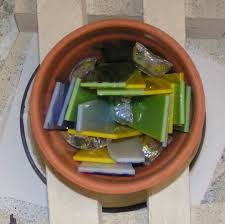The question of how to make thin
sheets arises from time to time. Unless
you are a glass manufacturer, it is unlikely you can make large, thin glass sheets. But you can approximate making thin sheets by
two methods that I know.
Sintering
One of these is sintering. This is firing the glass to a low temperature
and soaking for a long time. The common
form of this is powder wafers.
By using a screen to deposit an even
layer of glass powder you can make very thin, but delicate sheets of
glass. The procedure I would use is a
screen of about 45 – 60 threads per inch.
This is coarse enough to allow the powder through, but not so fine as to
“reject” large amounts of the coarser particles.
You can screen the powder directly
onto a kiln washed shelf, or onto Thinfire or Papyros. You will not be able to move the unfired
powder on a sheet of paper or fibre paper without changing the thickness and
shape of the screened powder. It must be
laid down onto the separator directly on the shelf. You can of course, move the shelf to the kiln
if you can get in without tipping it.
Method
Support the screen about 3mm above
the surface to allow the powder to fall through.
Make a ridge of powder at one end of
the screen. Using a smooth straight edge
wide enough to cover the whole of the screen, lightly spread the powder from
the starting end to the other. Then repeat drawing the powder to the starting
end. Make about five repeats of this –
that is 10 passes, to get enough powder laid down to form about 0.5 to 1mm
sheet. You will need to experiment with
the number of passes to get what you want.
Do not try to press the powder
through the screen. That will only wear
the screen out quickly and may tear it.
Each pass should be a light spreading of the powder. It is heavy enough to fall through the screen
without additional force.
You could, of course, just sift the powder over the area you want to
cover and judge by eye how even the layer is.
It is possible that your observation is good enough, but it is more
likely that you will have thick and thin areas.
Often even at sintering temperatures, the thin is pulled toward the
thicker, leaving small or large holes.
By screening the powder, you know you will have an even layer
Firing
The kind of schedule to use to sinter
the glass particles together without changing their structure is the following:
220°C to 482°C , soak for 60 mins
55°C to 593°C, 10 minutes
28°C to 665°C for 5 mins
as fast as possible to 482°C for 30 mins
28°C to 427°C, no soak
55°C to 370°C, no soak
110°C to 50°C, no soak
This will work for most fusing glasses.
This slow firing allows enough heat to penetrate the glass grains that
they will stick together without changing shape or developing holes. I admit the anneal cool is very
cautious. You can experiment with
quicker cools if you want to speed the process.
Pressing
This is a technique of thinning already existing sheets
of glass. Typically, you will have a 6mm
or thicker piece of glass that you want to be 3mm or less. Paul Tarlow has described this kiln pressed glass very
well in his books and on the fusedglass.org site.
In essence, you use a pair of kiln shelves. Kiln wash both shelves. Place the glass to be thinned on one shelf. At the outer edges of the shelf put down
spacers of the thickness you want the glass to be after pressing. This will keep the upper shelf from settling
down too much and more importantly unevenly.
Place the other shelf, kiln washed side down, on top of the glass. Be sure the spacers are in places where they
can support the upper shelf.
If you are thinning from 6mm to 3mm, normally you do not
need any additional weight on top of the upper shelf. But the thinner you want the glass to be, the
greater the weight needs to be. It could
be another shelf, fire bricks or steel weights.
When scheduling the annealing remember you must take
account of the mass of the weight on top of the glass. You will need a much longer temperature
equalisation soak and a much slower annealing cool.












